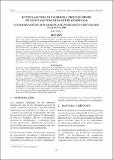Por favor, use este identificador para citar o enlazar este ítem:
https://hdl.handle.net/20.500.12958/4049Registro completo de metadatos
| Campo DC | Valor | Lengua/Idioma |
|---|---|---|
| dc.contributor.author | Pinedo, Elda | - |
| dc.date.accessioned | 2022-04-25T20:27:43Z | - |
| dc.date.available | 2022-04-25T20:27:43Z | - |
| dc.date.issued | 2022-03 | - |
| dc.identifier.citation | Pinedo, E. 2022. Ictioplancton, eufáusidos y biovolúmenes de zooplancton durante el otoño 2016. Inf Inst Mar Perú. 49(1): 33-41. | es_ES |
| dc.identifier.issn | 0378-7702 | - |
| dc.identifier.uri | https://hdl.handle.net/20.500.12958/4049 | - |
| dc.description.abstract | Del 21 de mayo al 16 de junio 2016, se realizó el Crucero de Evaluación Hidroacústica de Recursos Pelágicos 1605-06. Se recolectaron 108 muestras de zooplancton con red Hensen (330 μm) hasta 50 m de profundidad. Se determinaron huevos y larvas pertenecientes a 54 especies de 38 familias. Engraulis ringens fue la especie más frecuente y abundante, cuyos huevos (51%) y larvas (67%) oscilaron entre 3 y 33,732 huevos.m-2, así como 3 y 801 larvas.m-2, distribuyéndose en la franja costera dentro de las 30 mn, alcanzando máxima distancia de 70 mn frente a San Juan. Las tallas de las larvas fluctuaron entre 1,5 y 19 mm, siendo las más frecuentes (15 -18%) de 2,5 y 3,0 mm. Vinciguerria lucetia presentó importantes concentraciones con valores de 3 y 444 huevos.m-2, así como 3 y 246 larvas.m-2, que se encontraron por fuera de 20 mn. Se determinaron 4 géneros y 13 especies de eufáusidos. Nyctiphanes simplex, fue la especie más abundante (50%) cuya distribución fue en el área de muestreo. Los biovolúmenes de zooplancton oscilaron entre 0,2 y 60,0 mL/muestra, los valores menores a 5 mL/muestra fueron más frecuentes (48%). | es_ES |
| dc.description.abstract | ABSTRACT: The hydroacoustic assessment cruise took place from May 21 to June 16, during which, we collected 108 samples of zooplankton with Hensen net (330 μm) up to a depth of 50 m. A total of 54 species of eggs and larvae, belonging to 38 families, were determined. Engraulis ringens was the most frequent and abundant species, whose eggs (51%) and larvae (67%) ranged between 3 and 33,732 egg.m-2, and 3 and 801 larvae.m-2, respectively. It was distributed in the coastal strip within 30 nm, reaching a maximum distance of 70 nm off San Juan. Larval sizes fluctuated between 1.5 and 19 mm, being 2.5 and 3.0 mm the most frequent (33%). Vinciguerria lucetia showed significant concentrations with values of 3 and 444 egg.m-2 and 3 and 246 larvae.m-2, which were mainly distributed outside the 20 nm. We determined 4 genera and 13 species of euphausiids. Nyctiphanes simplex, was the most abundant species representing 50% of the total and whose distribution was throughout the sampling area. Zooplankton biovolumes ranged from 0.2 to 60.0 mL/sample, with values less than 5 mL/sample being the most frequent (48%). | - |
| dc.language | spa | - |
| dc.language.iso | spa | es_ES |
| dc.publisher | Instituto del Mar del Perú | es_ES |
| dc.relation.ispartofseries | Informe IMARPE 49(1), 2022; | - |
| dc.rights | info:eu-repo/semantics/openAccess | es_ES |
| dc.rights.uri | https://creativecommons.org/licenses/by/4.0/ | es_ES |
| dc.source | Instituto del Mar del Perú - IMARPE | es_ES |
| dc.source.uri | Repositorio Digital IMARPE | es_ES |
| dc.subject | Ictioplancton | es_ES |
| dc.subject | Zooplancton | es_ES |
| dc.subject | Anchoveta | es_ES |
| dc.title | Ictioplancton, eufáusidos y biovolúmenes de zooplancton durante el otoño 2016 | es_ES |
| dc.title.alternative | Ichthyoplankton, euphausiids, and zooplankton biovolumes in autumn 2016 | - |
| dc.type | info:eu-repo/semantics/article | es_ES |
| dc.publisher.country | Perú - Callao | es_ES |
| dc.subject.ocde | http://purl.org/pe-repo/ocde/ford#1.06.12 | es_ES |
| Aparece en las colecciones: | Informe vol. 49(1) 2022 | |
Ficheros en este ítem:
| Fichero | Descripción | Tamaño | Formato | |
|---|---|---|---|---|
| Informe 49-1 artículo2.pdf | 5,3 MB | Adobe PDF |  Visualizar/Abrir |
Este ítem está sujeto a una licencia Creative Commons Licencia Creative Commons

